Decision Making Under Risk and Uncertainty in Performance Management
VerifiedAdded on 2020/07/22
|6
|1367
|41
Report
AI Summary
This report provides a comprehensive analysis of how risk and uncertainty impact decision-making processes within performance management. It begins with an introduction to performance management and its dependence on effective decision-making, which is often complicated by inherent business risks. The report defines and differentiates between risk and uncertainty, illustrating their effects with examples. It then delves into various types of risk, including risk-seeking, risk-averse, and risk-neutral behaviors. Furthermore, the report evaluates different decision-making approaches under uncertainty, such as Maximin, Maximax, and Minimax-regret, and when probabilities of outcomes are available, the expected value approach is also discussed. The report concludes by summarizing the significant influence of risk and uncertainty on business decisions and the importance of considering these factors in management strategies. The report references several academic sources to support its arguments.
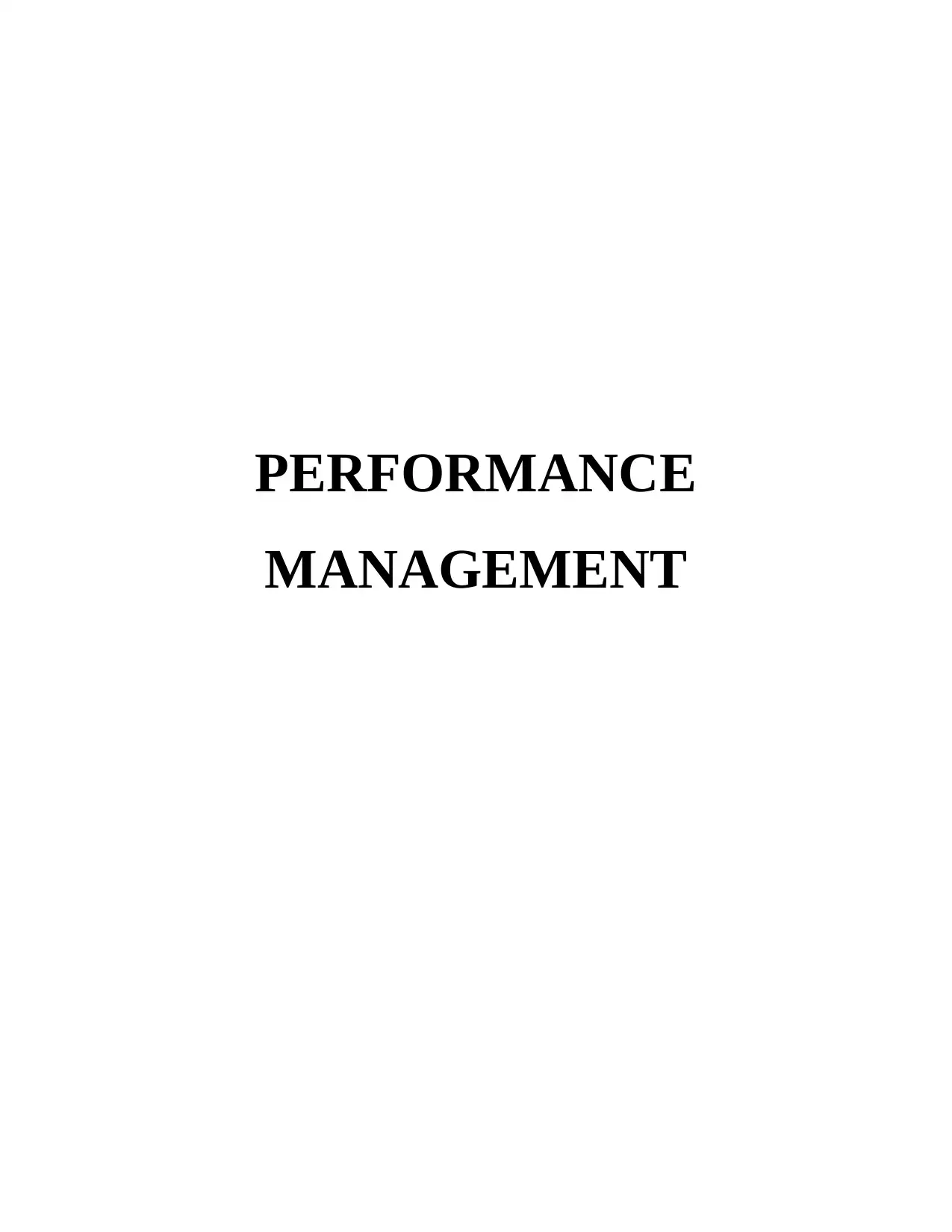
PERFORMANCE
MANAGEMENT
MANAGEMENT
Paraphrase This Document
Need a fresh take? Get an instant paraphrase of this document with our AI Paraphraser
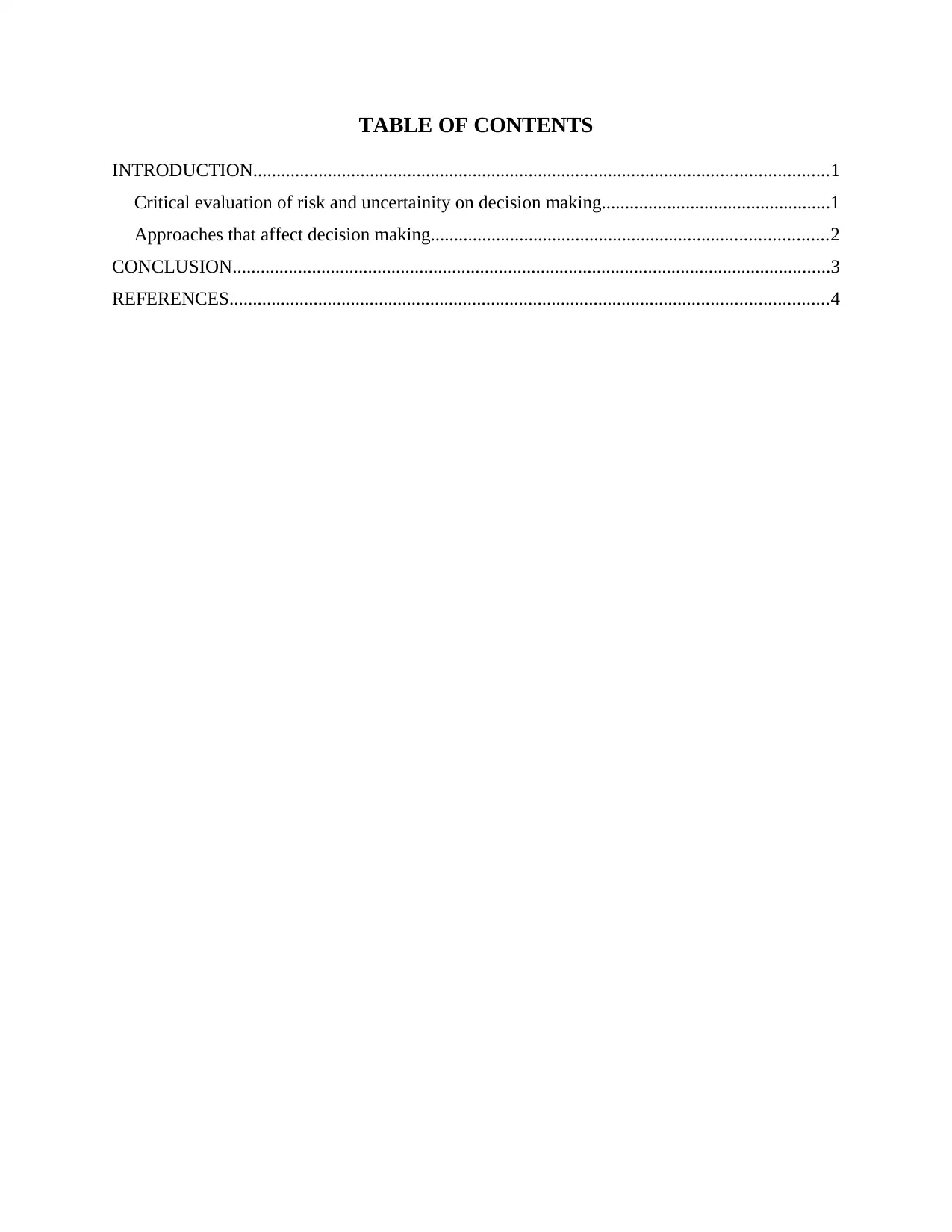
TABLE OF CONTENTS
INTRODUCTION...........................................................................................................................1
Critical evaluation of risk and uncertainity on decision making.................................................1
Approaches that affect decision making.....................................................................................2
CONCLUSION................................................................................................................................3
REFERENCES................................................................................................................................4
INTRODUCTION...........................................................................................................................1
Critical evaluation of risk and uncertainity on decision making.................................................1
Approaches that affect decision making.....................................................................................2
CONCLUSION................................................................................................................................3
REFERENCES................................................................................................................................4
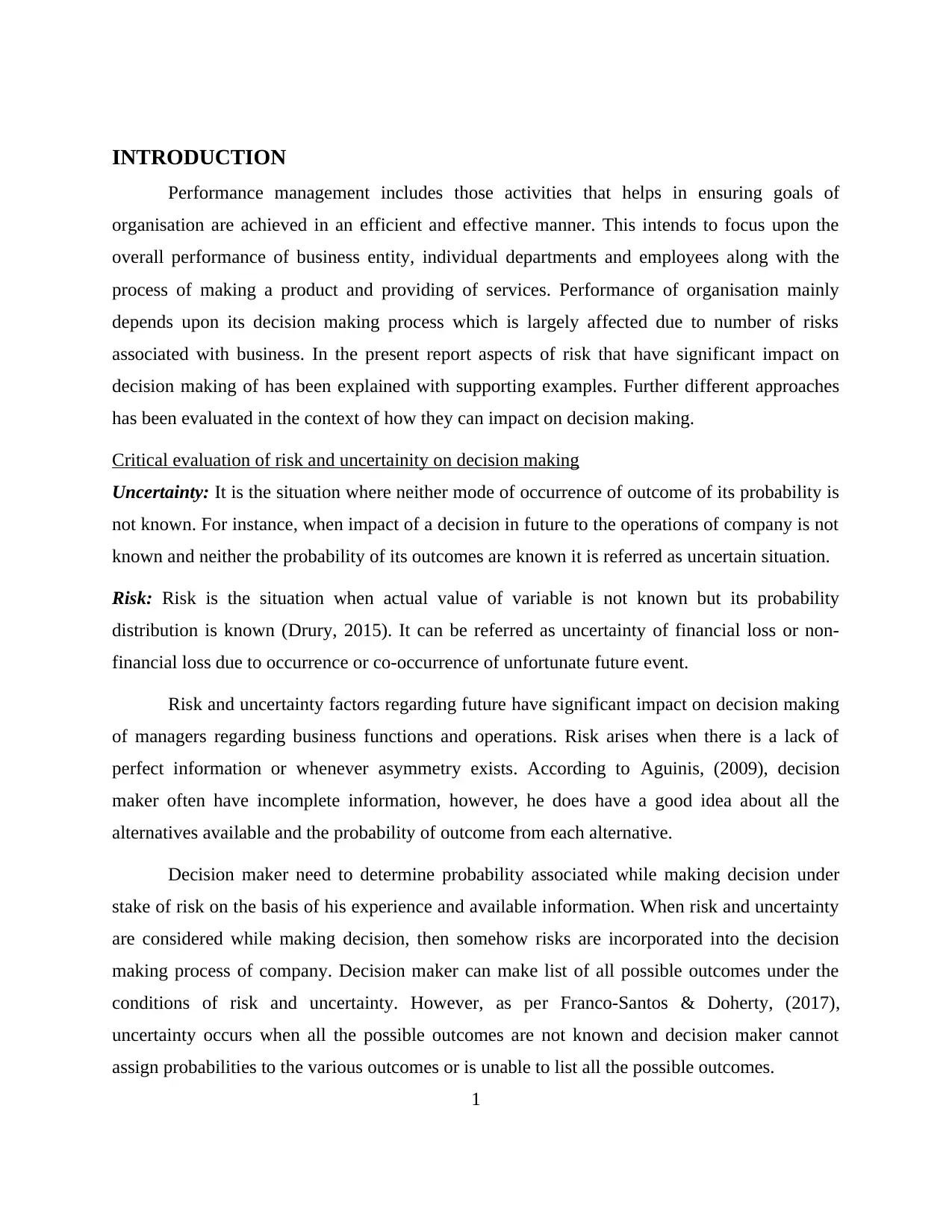
INTRODUCTION
Performance management includes those activities that helps in ensuring goals of
organisation are achieved in an efficient and effective manner. This intends to focus upon the
overall performance of business entity, individual departments and employees along with the
process of making a product and providing of services. Performance of organisation mainly
depends upon its decision making process which is largely affected due to number of risks
associated with business. In the present report aspects of risk that have significant impact on
decision making of has been explained with supporting examples. Further different approaches
has been evaluated in the context of how they can impact on decision making.
Critical evaluation of risk and uncertainity on decision making
Uncertainty: It is the situation where neither mode of occurrence of outcome of its probability is
not known. For instance, when impact of a decision in future to the operations of company is not
known and neither the probability of its outcomes are known it is referred as uncertain situation.
Risk: Risk is the situation when actual value of variable is not known but its probability
distribution is known (Drury, 2015). It can be referred as uncertainty of financial loss or non-
financial loss due to occurrence or co-occurrence of unfortunate future event.
Risk and uncertainty factors regarding future have significant impact on decision making
of managers regarding business functions and operations. Risk arises when there is a lack of
perfect information or whenever asymmetry exists. According to Aguinis, (2009), decision
maker often have incomplete information, however, he does have a good idea about all the
alternatives available and the probability of outcome from each alternative.
Decision maker need to determine probability associated while making decision under
stake of risk on the basis of his experience and available information. When risk and uncertainty
are considered while making decision, then somehow risks are incorporated into the decision
making process of company. Decision maker can make list of all possible outcomes under the
conditions of risk and uncertainty. However, as per Franco-Santos & Doherty, (2017),
uncertainty occurs when all the possible outcomes are not known and decision maker cannot
assign probabilities to the various outcomes or is unable to list all the possible outcomes.
1
Performance management includes those activities that helps in ensuring goals of
organisation are achieved in an efficient and effective manner. This intends to focus upon the
overall performance of business entity, individual departments and employees along with the
process of making a product and providing of services. Performance of organisation mainly
depends upon its decision making process which is largely affected due to number of risks
associated with business. In the present report aspects of risk that have significant impact on
decision making of has been explained with supporting examples. Further different approaches
has been evaluated in the context of how they can impact on decision making.
Critical evaluation of risk and uncertainity on decision making
Uncertainty: It is the situation where neither mode of occurrence of outcome of its probability is
not known. For instance, when impact of a decision in future to the operations of company is not
known and neither the probability of its outcomes are known it is referred as uncertain situation.
Risk: Risk is the situation when actual value of variable is not known but its probability
distribution is known (Drury, 2015). It can be referred as uncertainty of financial loss or non-
financial loss due to occurrence or co-occurrence of unfortunate future event.
Risk and uncertainty factors regarding future have significant impact on decision making
of managers regarding business functions and operations. Risk arises when there is a lack of
perfect information or whenever asymmetry exists. According to Aguinis, (2009), decision
maker often have incomplete information, however, he does have a good idea about all the
alternatives available and the probability of outcome from each alternative.
Decision maker need to determine probability associated while making decision under
stake of risk on the basis of his experience and available information. When risk and uncertainty
are considered while making decision, then somehow risks are incorporated into the decision
making process of company. Decision maker can make list of all possible outcomes under the
conditions of risk and uncertainty. However, as per Franco-Santos & Doherty, (2017),
uncertainty occurs when all the possible outcomes are not known and decision maker cannot
assign probabilities to the various outcomes or is unable to list all the possible outcomes.
1
⊘ This is a preview!⊘
Do you want full access?
Subscribe today to unlock all pages.

Trusted by 1+ million students worldwide
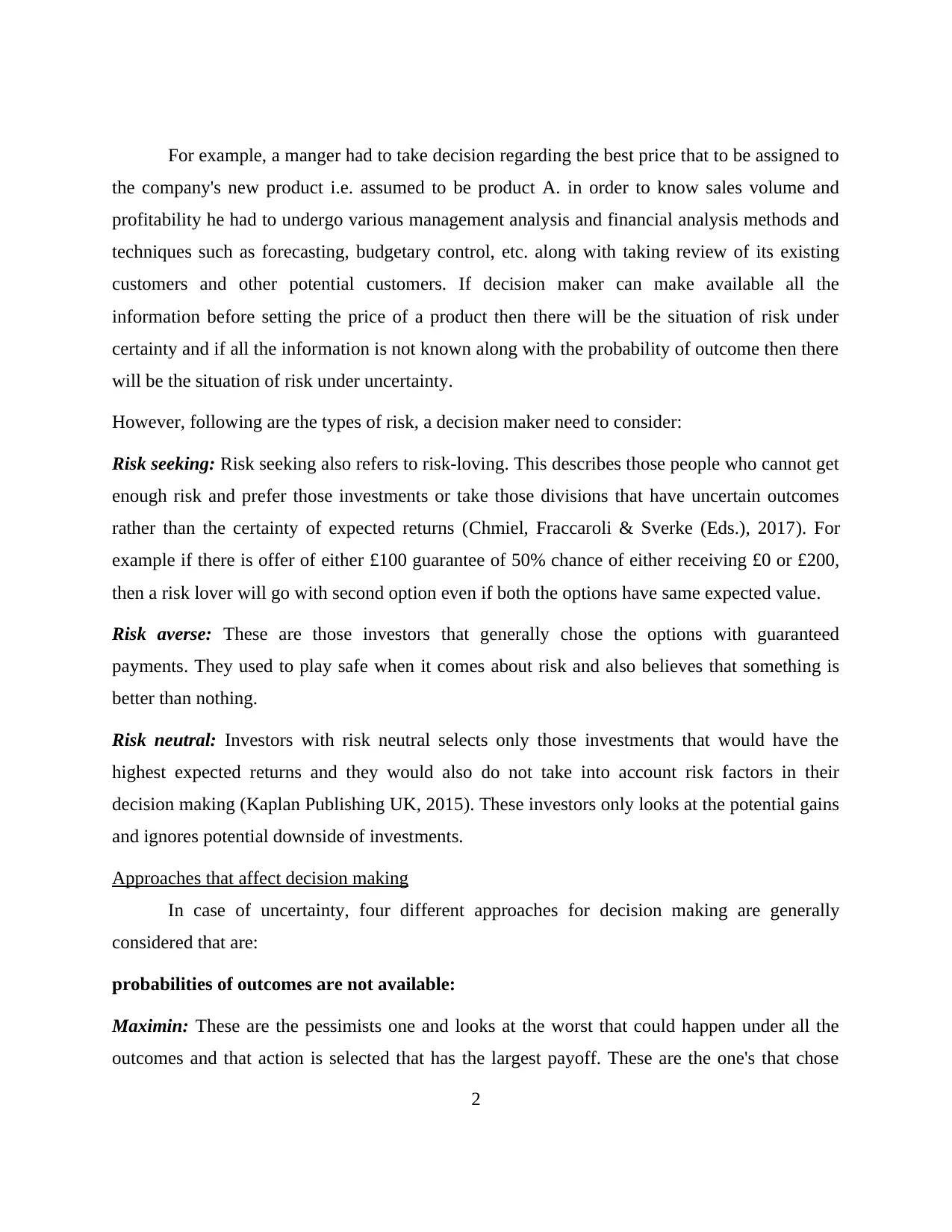
For example, a manger had to take decision regarding the best price that to be assigned to
the company's new product i.e. assumed to be product A. in order to know sales volume and
profitability he had to undergo various management analysis and financial analysis methods and
techniques such as forecasting, budgetary control, etc. along with taking review of its existing
customers and other potential customers. If decision maker can make available all the
information before setting the price of a product then there will be the situation of risk under
certainty and if all the information is not known along with the probability of outcome then there
will be the situation of risk under uncertainty.
However, following are the types of risk, a decision maker need to consider:
Risk seeking: Risk seeking also refers to risk-loving. This describes those people who cannot get
enough risk and prefer those investments or take those divisions that have uncertain outcomes
rather than the certainty of expected returns (Chmiel, Fraccaroli & Sverke (Eds.), 2017). For
example if there is offer of either £100 guarantee of 50% chance of either receiving £0 or £200,
then a risk lover will go with second option even if both the options have same expected value.
Risk averse: These are those investors that generally chose the options with guaranteed
payments. They used to play safe when it comes about risk and also believes that something is
better than nothing.
Risk neutral: Investors with risk neutral selects only those investments that would have the
highest expected returns and they would also do not take into account risk factors in their
decision making (Kaplan Publishing UK, 2015). These investors only looks at the potential gains
and ignores potential downside of investments.
Approaches that affect decision making
In case of uncertainty, four different approaches for decision making are generally
considered that are:
probabilities of outcomes are not available:
Maximin: These are the pessimists one and looks at the worst that could happen under all the
outcomes and that action is selected that has the largest payoff. These are the one's that chose
2
the company's new product i.e. assumed to be product A. in order to know sales volume and
profitability he had to undergo various management analysis and financial analysis methods and
techniques such as forecasting, budgetary control, etc. along with taking review of its existing
customers and other potential customers. If decision maker can make available all the
information before setting the price of a product then there will be the situation of risk under
certainty and if all the information is not known along with the probability of outcome then there
will be the situation of risk under uncertainty.
However, following are the types of risk, a decision maker need to consider:
Risk seeking: Risk seeking also refers to risk-loving. This describes those people who cannot get
enough risk and prefer those investments or take those divisions that have uncertain outcomes
rather than the certainty of expected returns (Chmiel, Fraccaroli & Sverke (Eds.), 2017). For
example if there is offer of either £100 guarantee of 50% chance of either receiving £0 or £200,
then a risk lover will go with second option even if both the options have same expected value.
Risk averse: These are those investors that generally chose the options with guaranteed
payments. They used to play safe when it comes about risk and also believes that something is
better than nothing.
Risk neutral: Investors with risk neutral selects only those investments that would have the
highest expected returns and they would also do not take into account risk factors in their
decision making (Kaplan Publishing UK, 2015). These investors only looks at the potential gains
and ignores potential downside of investments.
Approaches that affect decision making
In case of uncertainty, four different approaches for decision making are generally
considered that are:
probabilities of outcomes are not available:
Maximin: These are the pessimists one and looks at the worst that could happen under all the
outcomes and that action is selected that has the largest payoff. These are the one's that chose
2
Paraphrase This Document
Need a fresh take? Get an instant paraphrase of this document with our AI Paraphraser
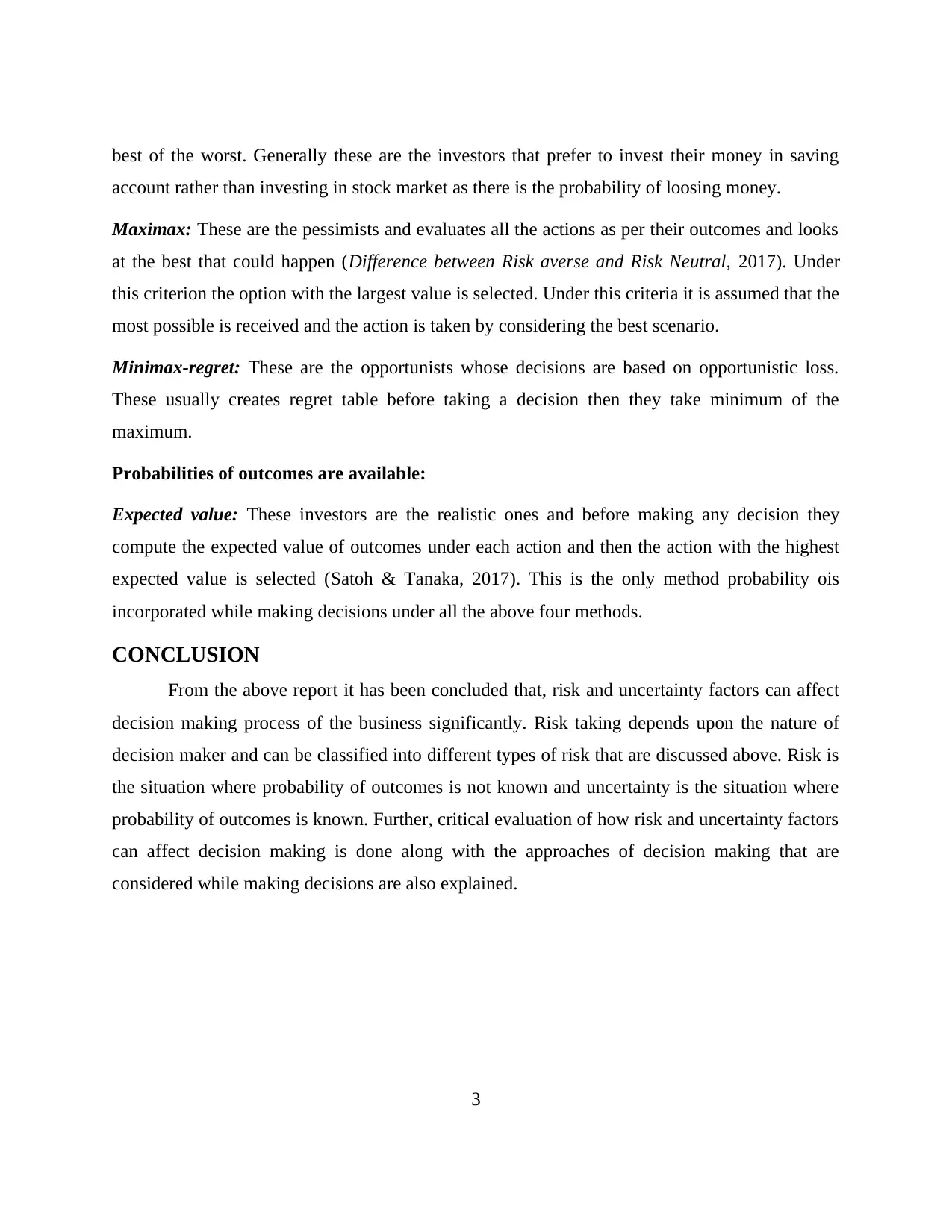
best of the worst. Generally these are the investors that prefer to invest their money in saving
account rather than investing in stock market as there is the probability of loosing money.
Maximax: These are the pessimists and evaluates all the actions as per their outcomes and looks
at the best that could happen (Difference between Risk averse and Risk Neutral, 2017). Under
this criterion the option with the largest value is selected. Under this criteria it is assumed that the
most possible is received and the action is taken by considering the best scenario.
Minimax-regret: These are the opportunists whose decisions are based on opportunistic loss.
These usually creates regret table before taking a decision then they take minimum of the
maximum.
Probabilities of outcomes are available:
Expected value: These investors are the realistic ones and before making any decision they
compute the expected value of outcomes under each action and then the action with the highest
expected value is selected (Satoh & Tanaka, 2017). This is the only method probability ois
incorporated while making decisions under all the above four methods.
CONCLUSION
From the above report it has been concluded that, risk and uncertainty factors can affect
decision making process of the business significantly. Risk taking depends upon the nature of
decision maker and can be classified into different types of risk that are discussed above. Risk is
the situation where probability of outcomes is not known and uncertainty is the situation where
probability of outcomes is known. Further, critical evaluation of how risk and uncertainty factors
can affect decision making is done along with the approaches of decision making that are
considered while making decisions are also explained.
3
account rather than investing in stock market as there is the probability of loosing money.
Maximax: These are the pessimists and evaluates all the actions as per their outcomes and looks
at the best that could happen (Difference between Risk averse and Risk Neutral, 2017). Under
this criterion the option with the largest value is selected. Under this criteria it is assumed that the
most possible is received and the action is taken by considering the best scenario.
Minimax-regret: These are the opportunists whose decisions are based on opportunistic loss.
These usually creates regret table before taking a decision then they take minimum of the
maximum.
Probabilities of outcomes are available:
Expected value: These investors are the realistic ones and before making any decision they
compute the expected value of outcomes under each action and then the action with the highest
expected value is selected (Satoh & Tanaka, 2017). This is the only method probability ois
incorporated while making decisions under all the above four methods.
CONCLUSION
From the above report it has been concluded that, risk and uncertainty factors can affect
decision making process of the business significantly. Risk taking depends upon the nature of
decision maker and can be classified into different types of risk that are discussed above. Risk is
the situation where probability of outcomes is not known and uncertainty is the situation where
probability of outcomes is known. Further, critical evaluation of how risk and uncertainty factors
can affect decision making is done along with the approaches of decision making that are
considered while making decisions are also explained.
3
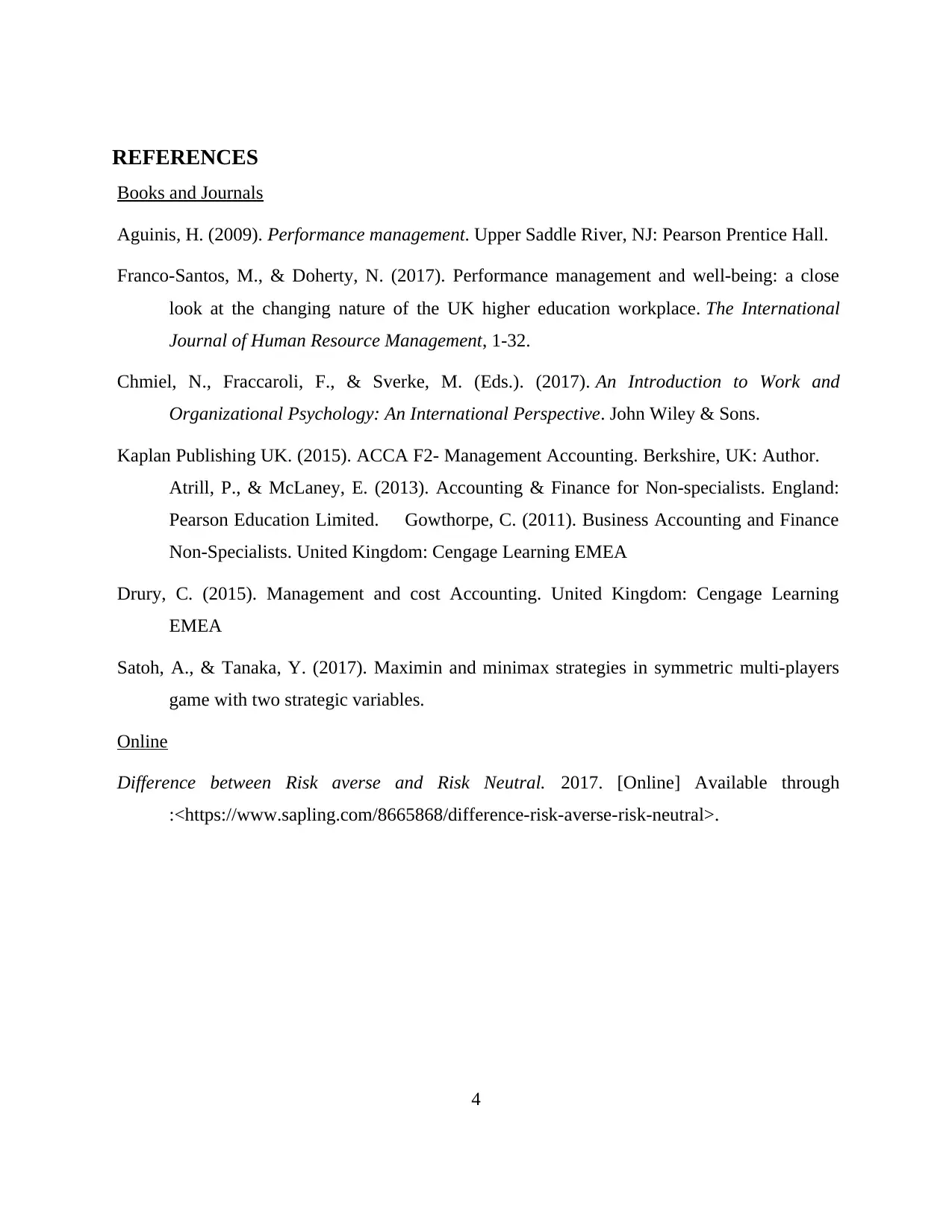
REFERENCES
Books and Journals
Aguinis, H. (2009). Performance management. Upper Saddle River, NJ: Pearson Prentice Hall.
Franco-Santos, M., & Doherty, N. (2017). Performance management and well-being: a close
look at the changing nature of the UK higher education workplace. The International
Journal of Human Resource Management, 1-32.
Chmiel, N., Fraccaroli, F., & Sverke, M. (Eds.). (2017). An Introduction to Work and
Organizational Psychology: An International Perspective. John Wiley & Sons.
Kaplan Publishing UK. (2015). ACCA F2- Management Accounting. Berkshire, UK: Author.
Atrill, P., & McLaney, E. (2013). Accounting & Finance for Non-specialists. England:
Pearson Education Limited. Gowthorpe, C. (2011). Business Accounting and Finance
Non-Specialists. United Kingdom: Cengage Learning EMEA
Drury, C. (2015). Management and cost Accounting. United Kingdom: Cengage Learning
EMEA
Satoh, A., & Tanaka, Y. (2017). Maximin and minimax strategies in symmetric multi-players
game with two strategic variables.
Online
Difference between Risk averse and Risk Neutral. 2017. [Online] Available through
:<https://www.sapling.com/8665868/difference-risk-averse-risk-neutral>.
4
Books and Journals
Aguinis, H. (2009). Performance management. Upper Saddle River, NJ: Pearson Prentice Hall.
Franco-Santos, M., & Doherty, N. (2017). Performance management and well-being: a close
look at the changing nature of the UK higher education workplace. The International
Journal of Human Resource Management, 1-32.
Chmiel, N., Fraccaroli, F., & Sverke, M. (Eds.). (2017). An Introduction to Work and
Organizational Psychology: An International Perspective. John Wiley & Sons.
Kaplan Publishing UK. (2015). ACCA F2- Management Accounting. Berkshire, UK: Author.
Atrill, P., & McLaney, E. (2013). Accounting & Finance for Non-specialists. England:
Pearson Education Limited. Gowthorpe, C. (2011). Business Accounting and Finance
Non-Specialists. United Kingdom: Cengage Learning EMEA
Drury, C. (2015). Management and cost Accounting. United Kingdom: Cengage Learning
EMEA
Satoh, A., & Tanaka, Y. (2017). Maximin and minimax strategies in symmetric multi-players
game with two strategic variables.
Online
Difference between Risk averse and Risk Neutral. 2017. [Online] Available through
:<https://www.sapling.com/8665868/difference-risk-averse-risk-neutral>.
4
⊘ This is a preview!⊘
Do you want full access?
Subscribe today to unlock all pages.

Trusted by 1+ million students worldwide
1 out of 6
Related Documents
Your All-in-One AI-Powered Toolkit for Academic Success.
+13062052269
info@desklib.com
Available 24*7 on WhatsApp / Email
![[object Object]](/_next/static/media/star-bottom.7253800d.svg)
Unlock your academic potential
Copyright © 2020–2025 A2Z Services. All Rights Reserved. Developed and managed by ZUCOL.





